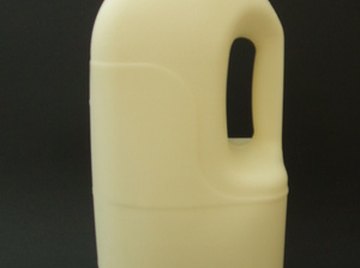
Manufacturers use polyethylene, a byproduct of oil, to create a wide variety of plastic products, from medical supplies to paper coatings. Low-density polyethylene (LDPE) provides increased pliability and decreased strength, making this material ideal for packaging applications, such as plastic bags and milk cartons. The wide use of LDPE results in large quantities of material for recycling.
Purpose
LDPE that is not recycled goes to landfill and consumes petroleum. According to the State of California Department of Conservation, over one billion LDPE water bottles ended up in California landfills in 2003. If recycled, these bottles could have used to create 74 million square feet of carpet or 16 million sweaters.
Identification
Manufacturers stamp plastics with an identifying number, ranging from one to seven, which indicate how these materials may be recycled. LDPE is identified by the recycling symbol, which consists of a triangle with three arrows on the outside, with the number 4 in the middle. Usually this recycling mark is stamped near the list of ingredients on a package. It may also be imprinted on the plastic container.
Considerations
Recyclers may find the number 4 recycling symbol on a great many products, but low density polyethylene most commonly is found in bottled water packaging. Shopping bags, milk cartons and garbage bags typically are created from polyethylene. Any types of plastics, which are thin and very soft, usually are formed out of low density polyethylene, so check the product carefully for the recycling symbol.
Prevention
Most neighborhood recycling centers accept high and low density polyethylene plastic recycling. Dropping LDPE products off weekly at a recycling center may reduce pollution, and lessen demand for raw materials. There are various ways to reduce the use of plastic, such as reusing plastics when possible, purchasing large drums of water (usually available outside your local grocery store), using paper bags when shopping, and shopping with cloth bags, which can be reused for years on end.
Recycling Process
After individuals drop LDPE products off at a recycling center, the recycling company melts the plastic to eliminate contaminants. After putting the low density polyethylene under heat, the material is fashioned into thin plastic sheets, which the recycling company then sells to manufacturers. Contrary to popular belief, recycled plastic bottles are not turned into more plastic bottles. The degradation in the material makes LDPE useful in other applications, such as treating carpet or manufacturing clothing.
References
About the Author
Chris Hamilton has been a writer since 2005, specializing in business and legal topics. He contributes to various websites and holds a Bachelor of Science in biology from Virginia Tech.
Photo Credits
Container of milk. Plastic milk bottle image by L. Shat from Fotolia.com
